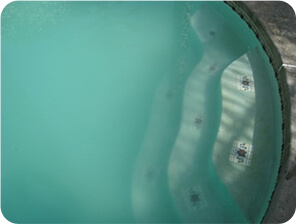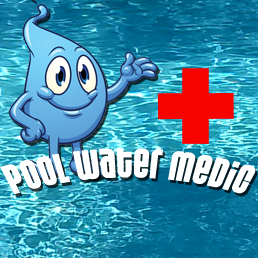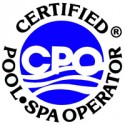Preventing Cloudy Pool Water
ByHow to prevent and eliminate cloudy water
 As bather loads peak in the summer heat, it is that time of the year again when sparkling clear water can become clouded and unsanitary. What is a pool operator to do? Cloudy water is an indication that the disinfection and filtration systems are not keeping up with the load being placed on them by the number of bathers using the pool. Cloudy water is not just unappealing to the bather. It can also be a health hazard by inducing potential spread of illnesses and decreasing the lifeguards’ ability to see submerged drowning victims. There are many reasons water can become cloudy. Let’s break down the causes, then review the remedies of unsightly and potentially hazardous water.
As bather loads peak in the summer heat, it is that time of the year again when sparkling clear water can become clouded and unsanitary. What is a pool operator to do? Cloudy water is an indication that the disinfection and filtration systems are not keeping up with the load being placed on them by the number of bathers using the pool. Cloudy water is not just unappealing to the bather. It can also be a health hazard by inducing potential spread of illnesses and decreasing the lifeguards’ ability to see submerged drowning victims. There are many reasons water can become cloudy. Let’s break down the causes, then review the remedies of unsightly and potentially hazardous water.
In this prevention advisor we will discuss:
- Cloudy Water Common Causes
- Combating the Cloudiness
- Water Clarifiers
- Algae
Common Causes for Cloudy Water
High bather loads with improper filtration, insufficient water circulation or flow rate, and poor water chemistry are the usual culprits that cause cloudy water. A pool’s turnover rate should not exceed the maximum time required by your state’s swimming pool codes, usually 6 or 8 hours. It is important that the circulation system runs 24/7.
Cloudiness is the result of particles that are too tiny to be filtered or removed from the water through oxidation. Environmental factors contribute to the existence of these particles, such as wind, rain, vegetation, and even the pool users themselves with dry skin flakes, bacteria, cosmetics, and residues of the skin.
Combating the Cloudiness
The first step in regaining control of the water’s transparency is to check the filtration system. Sometimes, resolving the issue can be as easy as cleaning the filter and re-establishing the proper flow and turnover rates. Products are also available that are designed to clean specific types of filter media.
Proper water balance is important to help prevent cloudy water. High alkalinity and pH levels can cause cloudy water. Using the saturation index, make the necessary adjustments to bring the water back into harmony.
Water Clarifiers
The majority of water clarifiers are in liquid form, but there are solid granular forms available. Depending on the directions, most clarifiers will require the product to be diluted or poured over the surface of the water. Make sure to follow manufacturer’s instructions on how to apply any chemicals.
Organic Water Clarifiers
Synthetic polyelectrolytes or polymeric coagulants are the most common organic clarifiers. They usually have a positive charge called cationic clarifiers, which directly combat the negative electrical charges within the particles that cause cloudy water.
Inorganic Water Clarifiers (Flocculants)
A common inorganic water clarifier is aluminum sulfate, known as alum. It forms a gelatinous mass that traps the microscopic suspended particles. As larger and larger particles are formed, they sink to the bottom of the pool. The circulation system must operate for a period of time to let the alum and particles to properly combine to create these larger particles. The circulation flow will then be suspended for 12-24 hours, this process is called flocculation. When the flocculated particles collect on the floor of the pool, the operator will then vacuum the bottom of the pool.
Algae
Algae are one-celled plants that become a major concern for operators. Algae comes in several forms: green, yellow, or black. If left unchecked, algae growth can contaminate a clean and clear pool in about the span of a day.
Green algae - by far the most common and easily controlled.
Black algae - usually grow on pool walls in areas of poor circulation, like deep corners.
Yellow algae (aka mustard) – difficult to control and often treated with specifically formulated algicides.
Maintaining proper disinfectant and pH levels will help prevent the growth of algae. Algae growth is supported with environmental conditions such as light and temperature. Unfortunately, swimming pools provide all the nutrients needed to grow algae: carbon, hydrogen, oxygen, nitrogen, and phosphorous. These nutrients come from the water itself because of the hydrogen, oxygen and total alkalinity, which contains carbon and oxygen. Skin fragments, dead bacteria, cosmetics, some swimming pool treatment chemicals, chemical cleaners, soils, fertilizers, bird dropping, and dead instincts also contain nitrogen and phosphorous-like contaminants.















